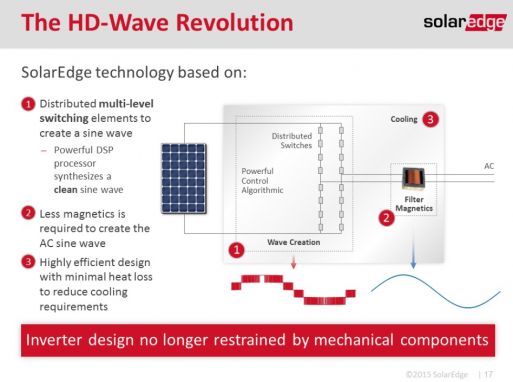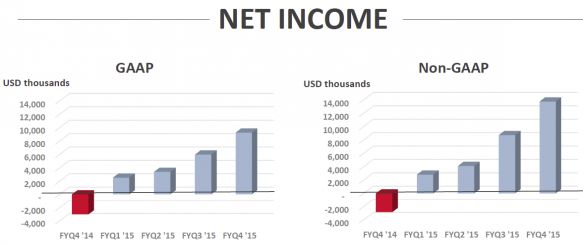SolarEdge designs and builds module-level power electronics, the fastest-growing segment of the PV inverter market.
The recently-public, Israel-based company is unveiling a radical change in PV inverter design that will trim the device of expensive and heavy magnetics, copper and aluminum, according to Lior Handelsman, VP of product strategy and marketing. The new design will be rolled out later this year and will eventually migrate to the entire product line.
Following Westinghouse's law rather than Moore's
Handelsman pointed out that inverter performance, judged by the metric of power per kilogram, has "not shown a lot of improvement" over the last 25 years. That power-per-kilogram metric, he suggests, takes into account that half the cost of inverters is contained in aluminum enclosures, magnetic inductors and wound copper -- and these commodities don't get cheaper or follow a learning curve.

The VP told GTM that it can eliminate magnetics, copper and aluminum from PV inverters by "emulating" higher frequency switching without having to move to expensive, non-silicon materials like silicon carbide or gallium nitride. He said, "We found a new way: stacking low-voltage switches with low ohmic resistance that behave like and emulate a high-frequency switch."
The company also touts the benefits of "distributed switching and powerful digital signal processing to synthesize a clean sine wave for a dramatic reduction in the magnetics and heavy cooling elements" that will allow for a decrease in inverter size and weight, along with record efficiency.
Handelsman claims the new architecture will use one-sixteenth the magnetics by weight, and less than one-half of the cooling metal. He said that commercializing this design was "a direction that no one else took." He added that going to a higher frequency using silicon-carbide components "would be a bad decision."

Dispensing with insulated-gate bipolar transistors in favor of standard silicon switches and "using a lot of low-voltage metal-oxide-semiconductor field-effect transistors (MOSFETs)" switching at high speeds lets SolarEdge use thin-film capacitors instead of electrolytics. These are the same MOSFETs that SolarEdge already uses by the millions for high-speed switching in its optimizers.

SolarEdge estimates that its 7.6-kilowatt inverter -- currently weighing in at 55 pounds and 98 percent efficiency -- would be 25 pounds and 99 percent efficient with the new circuit. Handelsman cautioned that the ramp-up will take time and that the cost benefit won't happen on day one.
An anonymous source with experience in power electronics suggests that SolarEdge is describing some variation of a multi-level inverter, widely used in high-voltage grid-level power converters. There are a number of different multi-level inverters. What is "common to most of them is that they increase the effective frequency seen by the inductor, so that it can be much smaller. That and the fact that they generate a staircase-like voltage that more closely resembles a sinusoid, means that they need less filtering, which again means reduced copper in transformer or inductors," the source said.
The source also notes the drawbacks to this approach, which include the potential for unreliability from single points of failure -- a problem that's addressable by adding some redundancy. Another pitfall of this architecture was identified by the source as well: "You not only need N switches...but you also need N gate drivers, N level shifters for the gate signals, and N isolated power supplies for the gate drivers. This is usually what makes it unattractive from a cost point of view, since gate drivers and isolated power supplies cost much more than the switches." Furthermore, these inverter designs are "more difficult to control, and require sophisticated sensing and feedback to run well both in steady state and during faults and startup."
Nevertheless, the source is a "believer" in this type of inverter, especially "as we integrate much of the functionality in a single package."
Scott Moskowitz, a solar analyst with GTM Research adds, "SolarEdge has found a way to shrink the size of its inverter using off the shelf components rather than high band-gap materials such as silicon carbide and gallium nitride. Its new architecture makes it among the first to bring dramatically smaller inverters to market (startup HiQ has been the leader in the distributed space for power per kilogram with its three phase design). Though the industry will take time to vet the product for reliability and SolarEdge will have to prove that the new design enables lower costs, not just smaller size, we expect the market to shift towards these smaller designs."
Recent financials
SolarEdge announced record revenues of $98.4 million for its most recent quarter. Revenue was $325.1 million for the fiscal year, up 144 percent year-over-year with record gross margin of 25.2 percent. Net income for fiscal year 2015 was $21.1 million compared to a net loss of $21.4 million in fiscal year 2014. SolarEdge shipped 920 megawatts in fiscal year 2015.
Figure: SolarEdge Units Shipped

Figure: SolarEdge Net Income




